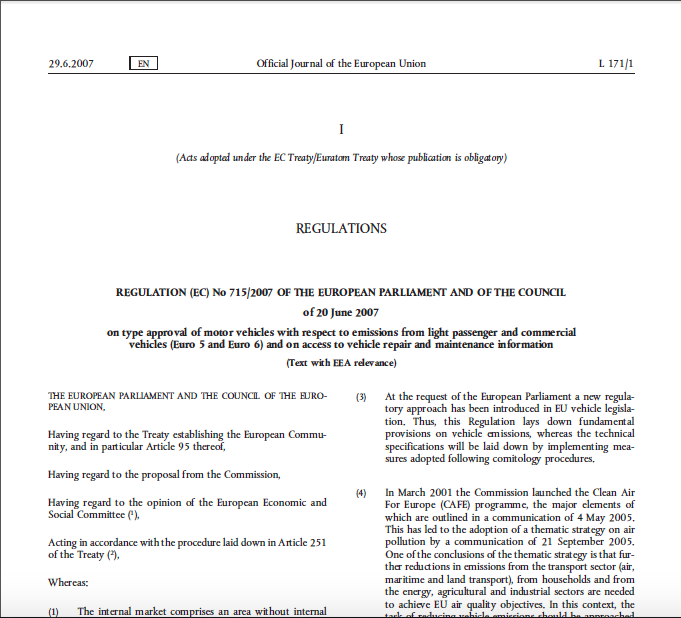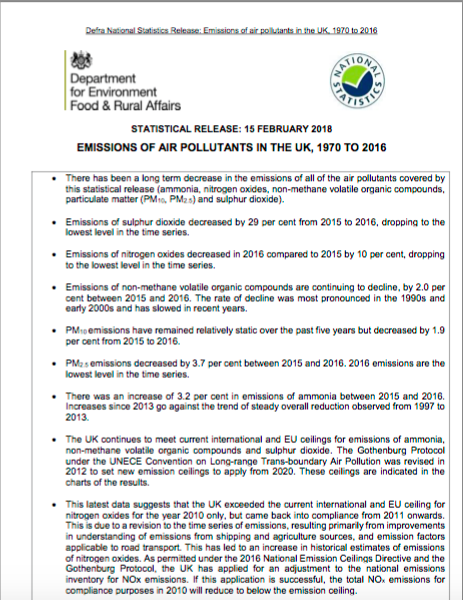In this section the emissions of Nitrous Oxides from exhaust pipes are studied and how this could change for Great Britain as a whole by 2050 is modelled for each scenario. Currently the annual tailpipe emissions of Carbon Dioxide is 148 thousand tonnes (1).
Modelling Technique
As with the Carbon Dioxide model, firstly emissions values for each vehicle type were established. To do this for Nitrous Oxides, the Euro 5 and 6 standards were considered (2), as well as the Real Driving Emissions Values and revisions to these values.
For petrol the Euro 6 values were used throughout. However for diesel engines, the RDE values were taken, with the initiative to reduce this value for 2020 applied for 2020-2050. To get the value for ICE, currently there is approximately a 50/50 split in Great Britain of Petrol to Diesel and so the values for and average of the petrol and diesel values were taken to provide the final ICE value.
For hybrids an average of the highest vehicles and lowest emitting models was taken.
For more information on Euro 6 and RDE please see our EU policy page.
For petrol the Euro 6 values were used throughout. However for diesel engines, the RDE values were taken, with the initiative to reduce this value for 2020 applied for 2020-2050. To get the value for ICE, currently there is approximately a 50/50 split in Great Britain of Petrol to Diesel and so the values for and average of the petrol and diesel values were taken to provide the final ICE value.
For hybrids an average of the highest vehicles and lowest emitting models was taken.
For more information on Euro 6 and RDE please see our EU policy page.
The same modelling technique as in the Carbon Dioxide model is used to give a final value of the total annual Nitrous Oxides tailpipe emissions in 2050.
Results
The results for the total volume of Nitrous Oxide tailpipe emissions in Great Britain in 2050 for the Business as Usual, the Conservative and the Aggressive scenario are outlined below.
For the description of each scenario visit our scenario page here, and for the results for the other six scenarios, please visit our results page.
For the description of each scenario visit our scenario page here, and for the results for the other six scenarios, please visit our results page.
Business as Usual
For the business as usual scenario the total amount of Nitrous Oxides emitted from exhausts for all cars in Great Britain was calculated to be
42 thousand tonnes.
The reduction with this scenario is due to not only the slight increase in EV on the road but also the more strict limits imposed in the model. It can be seen through this scenario that even if the number of EVs does not increase significantly, there will be a significant reduction in Nitrous Oxides emissions as Internal Combustion Engines become better and do not emit such high levels of Nitrous Oxides as they do now. As the reduction in emissions from ICE due to the standards imposed by the EU is intrinsic to the model, this effect will be seen in all scenarios. However the introduction of EV and hybrids at higher rates such as in other scenarios would reduce this number further.
For the business as usual scenario the total amount of Nitrous Oxides emitted from exhausts for all cars in Great Britain was calculated to be
42 thousand tonnes.
The reduction with this scenario is due to not only the slight increase in EV on the road but also the more strict limits imposed in the model. It can be seen through this scenario that even if the number of EVs does not increase significantly, there will be a significant reduction in Nitrous Oxides emissions as Internal Combustion Engines become better and do not emit such high levels of Nitrous Oxides as they do now. As the reduction in emissions from ICE due to the standards imposed by the EU is intrinsic to the model, this effect will be seen in all scenarios. However the introduction of EV and hybrids at higher rates such as in other scenarios would reduce this number further.
Conservative
For the conservative scenario the total amount of Nitrous Oxides emitted from exhausts for all cars in Great Britain was calculated to be
12 thousand tonnes
The remaining ICE and the large number of hybrids in 2050 accounts for the remaining emissions. As there is a relatively large number of EV compared to the Business As Usual scenario and hybrid emit less than ICE, a large reduction is still seen.
For the conservative scenario the total amount of Nitrous Oxides emitted from exhausts for all cars in Great Britain was calculated to be
12 thousand tonnes
The remaining ICE and the large number of hybrids in 2050 accounts for the remaining emissions. As there is a relatively large number of EV compared to the Business As Usual scenario and hybrid emit less than ICE, a large reduction is still seen.
Aggressive
For the aggressive scenario the total amount of Nitrous Oxides emitted from exhausts for all cars in Great Britain was calculated to be
2 thousand tonnes
Again as with the Carbon Dioxide emissions, this large reduction comes from the large number of EV in the market and the very low number of ICE. This would have a large impact on the total domestic emissions(3) and total transport emissions(1) of Nitrous oxides.
For the aggressive scenario the total amount of Nitrous Oxides emitted from exhausts for all cars in Great Britain was calculated to be
2 thousand tonnes
Again as with the Carbon Dioxide emissions, this large reduction comes from the large number of EV in the market and the very low number of ICE. This would have a large impact on the total domestic emissions(3) and total transport emissions(1) of Nitrous oxides.
This large reduction in Nitrous Oxides emission is increasingly important, especially to tackle poor air quality in cities. However as with in Carbon Dioxide, a wider consideration of the other area of transport, industry and further sectors which emit Nitrous Oxides in Great Britain must be considered.
Another important consideration with Nitrous Oxides is the values themselves. This model is based on the Euro 6 values, with controversy around whether the values stated by manufacturers are correct, there is a risk that the policy values may not be met and therefore the model will not fully reflect values of the cars on the road.
In the next section we will discuss Particulate emissions from EV.
Another important consideration with Nitrous Oxides is the values themselves. This model is based on the Euro 6 values, with controversy around whether the values stated by manufacturers are correct, there is a risk that the policy values may not be met and therefore the model will not fully reflect values of the cars on the road.
In the next section we will discuss Particulate emissions from EV.





